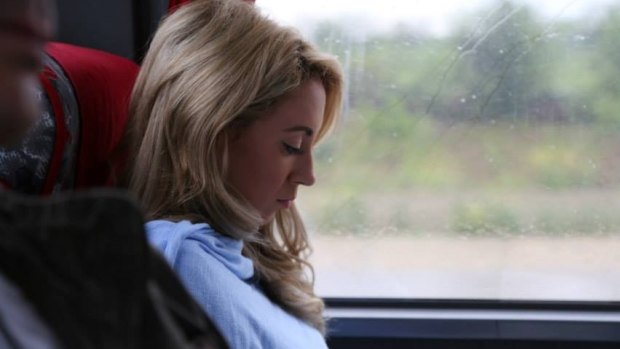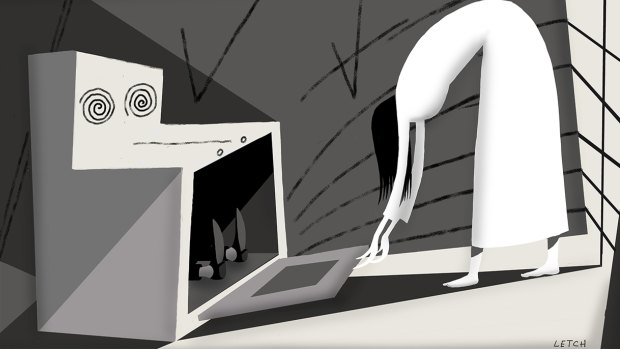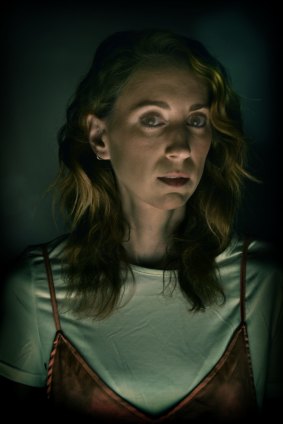By Kate Aubusson
I get a lot done in my sleep.
I rearrange my book shelves, model sartorially criminal outfits, Google intriguing yet completely fruitless trivial facts, like "Ireland's first doberman wicket keeper", and carry on delightful conversations with my bleary-eyed partner who, frankly, does not bring much to the conversation at 3am.
I am an epic sleepwalker. A world-class somnambulist. I defy you to find a better nightwalker. And it is magnificent.
I love the feeling of handing over the steering wheel to someone else when I close my eyes at night. Let's call her Sleep Kate.

Kate Aubusson during one of her rare stationary naps.
I like finding Sleep Kate's tell-tale signs when I wake up in the morning. A spoon of peanut butter in the toothbrush holder, a pillow fort in the wardrobe. Sure, it's a pain when I unpick a two-metre scarf I'd knitted the day before, or I can't find my gym bag for a month because it's in the oven, but this really says more about my aversion to cooking and Sleep Kate's aversion to exercise than anything else.
I'm sympathetic to the concerns of the sound-sleeping majority, who may be a little wary – if not terrified – of the sleepwalking minority.
We're not a zombie horde. But with our vacant expressions and unpredictable wanderings as the rest of you sleep, vulnerable in your nighties, we can be pretty unsettling.
A smattering of headlines in recent months has foreshadowed terrible, horrible things that come of sleepwalking: The US sleepwalking into the era of Donald Trump, Britain sleepwalking out of the EU, and the EU sleepwalking into a geopolitical crisis.

Illustration: Simon Letch
Worried, sleep-deprived mothers ask their Facebook communities for help settling their sleepwalking children. Should they put a baby gate at the top of the staircase for their 10-year-old nightcrawler? Or tie cowbells to the ankles of their eight-year-old who materialises, expressionless, behind the couch?
Sleepwalking has a dark mysticism for some that harkens back to folktales of people possessed by spirits and virgins controlled by sexy vampires.

Kate Aubusson Credit: Steven Siewert
But for the most part Sleep Kate is a lovable rogue. On Wednesday night she threw her arms over my partner on and told him "it's OK, everything is going to be all right". If you catch her mid-dream she'll take you with her on fantastical adventures; rescuing explorers trapped inside petrified amber, or finding a boat that will sail you to Thailand.
She might walk into a cupboard, get stuck and need rescuing herself, but she's generally pretty independent.
Sure, I once dreamt I was strangling an assailant only to have my then boyfriend shake me awake to tell me I had been pawing at his neck, but he was fine (I never told him about the dream. I like to think that was a benevolent kindness).
On a snowboarding trip in Canada the same boyfriend had to drag me back to bed after he found me – barefooted and in cotton pyjamas – standing on the threshold of the warm room doorway that led to the snowfields and minus 15 degree temperatures.
There is an invidious, deeply disturbing side to sleepwalking.
Highly publicised cases of murders committed by sleepwalkers, and stilnox car crashes would be the stuff of nightmares if they weren't a horrific reality of the victims and their families.
In 1943, a 16-year-old girl in the US was found not guilty after she shot her father and six-year-old brother during a sleepwalking episode in which she had dreamed she was under attack.
In 2015, a father in North Carolina who strangled his four-year-old son to death and attacked his two other children was acquitted of murder after his defence argued he was "violently sleepwalking".
It's a plausible defence in Australia. Our laws stipulate a person cannot be guilty of an offence if they were unconscious or asleep at the time that the act was committed.
In 1950, 50-year-old Ivy Cogdon became the first person in Australia to successfully use the sleepwalking defence in a murder trial after she killed her daughter with an axe while she slept. Cogdon said she was trapped in a nightmare in which she thought she was protecting her daughter from Korean soldiers who had invaded her suburban home.
The defence fails more often than it vindicates.
In 2010, Perth man Vernon Robert Silich claimed he had sleepwalked into his parent's room after drinking heavily over dinner. He killed his mother and father in their sleep by kicking them to death with his steel-capped boots. The sleepwalking defence didn't convince the jury, who sentenced him to life imprisonment.
I interviewed an expert witness on the Silich case, a psychiatrist who tore apart the claims of multiple convicted murderers who had invoked the sleepwalking defence. He told me the actions were too complex for someone to execute in their sleep; including Silich finding and lacing up his steel-capped boots.
I didn't tell him I was a sleepwalker. I trusted his expertise. Still do. And I'm not about to question the decision of a jury.
I just don't know what to make of the seeming intricate tasks I perform on my nighttime jaunts.
I once got dressed, slung a bag over my shoulder, grabbed the car keys and made my way out to the carport. Luckily I grabbed my parents' keys instead and woke up fumbling at the car door.
I've sat up in bed and carried on an in-depth job interview with an invisible manager. (I got the job.)
Sometimes I remember a fair chunk of my sleep jaunts, which according to some sleep boffins means I might not really be sleepwalking; it doesn't fit the deep sleep stage non-REM parasomnia diagnosis that characterises sleepwalkers.
But most of the time I have to rely on other people to fill me in once I've woken up.
I asked my father if he and mum worried when I was a child. He said they always locked the doors and made sure they could reach the keys in a hurry just in case I lit a fire. I don't think I'll share the fire scenario with the concerned mothers on Facebook.
But I would like to tell them that sleepwalking is far more common than once thought. One in 10 children and one in 50 adults are thought to sleepwalk at some stage.
Research suggests it could be hereditary, which doesn't surprise me. My sleep-driving attempt may have been foiled, but my Dad accomplished what I couldn't, motoring down a country road with a snoozing mate in the back seat.
A recent meta-analysis suggests 6.9 per cent of people will sleepwalk at some point in their lives, though most children grow out of it in their tweens. Poor little tikes. They're the ones who know what they're missing.
I once mentioned to a GP that I sleepwalked. She gave me a referral to a sleep clinic. But you couldn't pay me enough to get rid of Sleep Kate.
Besides, I lost that referral. I'll probably find it in the oven if I cared to look.
Kate Aubusson is health editor.